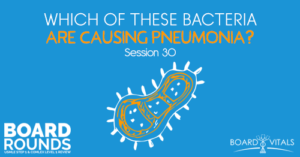Get 20% off a Single 1-on-1 Expert Advising Session Use it for ANYTHING! Learn More!

This 63-y/o with sickle cell and history of ETOH use is febrile, tachypneic, hypotensive, and has a focal infiltrate in the LLL. What’s the causative agent?
I’m joined once again by Dr. Karen Shackelford from BoardVitals. If you’re looking for some more in-depth help on your board prep, check out their amazing QBanks that will help you prepare for your board exam. Use the promo code BOARDROUNDS to save 15% off your purchase.
Listen to this podcast episode with the player above, or keep reading for the highlights and takeaway points.
A 63-year-old man who has a history of sickle-cell anemia and alcohol abuse has outlived his life expectancy. He presents a four-day history of productive coughing, subjective fevers, and the left side of chest discomfort that worsens with deep breathing.
On initial evaluation, his temperature is 39 degrees Centigrade or 102.2 Fahrenheit. Blood pressure is 100/60 mmHg, the pulse is 103, and respirations are 40/min. Lung auscultation reveals bronchi in the left lower lung field. Chest x-ray shows a focal infiltrate in the left lower lobe.
Which of the following is most likely to describe the causative organism?
(A) Gram-negative beta-hemolytic aerobic rod
(B) Gram-positive alpha-hemolytic diplococcus
(C) Gram-positive beta-hemolytic coccus
(D) Gram-positive beta-hemolytic diplococcus
(E) Gram-negative bacillus
It sounds like we’re dealing with potential pneumonia here, specifically community-acquired pneumonia versus aspiration pneumonia.
Karen doesn’t see any risk factor here for aspiration from alcohol abuse in itself. It could be community-acquired pneumonia based on history.
The most common cause of community-acquired pneumonia is Streptococcus pneumonia (pneumococcus). It typically causes that classic lobar infiltrate. The onset of the illness occurs over a few days. It’s associated with productive cough, fevers, and pleuritic chest pain that localizes to the area of the infiltrate.
Factors that increase the risk of pneumococcus include smoking, alcohol abuse, and COPD. People who are asplenic are at risk for infection with encapsulated organisms like pneumococcus.
Somebody with sickle-cell anemia who’s functionally hyposplenic at 63 years old is really a long life span. They would be functionally hyposplenic from splenic infarction and they would be at an increased risk than for pneumococcus and they should be vaccinated.
The pneumococci are microbiologically gram-positive alpha-hemolytic, biosoluble catalyzed negative diplococci and typically optigen-susceptible. So the correct answer is B.
This goes back to an algorithm chart that you essentially memorize for the USMLE Step 1. They would usually have microbiology questions that involve the identification of different characteristics of pathogens.
Answer choice A is a less common cause of community-acquired pneumonia.
Staph aureus is a gram-positive beta-hemolytic cocci. It’s very virulent and it can cause a classic lobar pneumonia. You would typically see this after influenza or viral pneumonia or secondary staph bacteremia.
Enterococcus fits the description for Choice D. It’s a gram-positive beta-hemolytic diplococci, which rarely causes pneumonia. It’s most commonly seen in urinary tract infections, endocarditis, and meningitis.
Legionella is the gram-negative bacillus and it causes atypical pneumonia. It’s typically associated with contaminated water sources in large communal facilities. It’s also associated with hyponatremia and gastrointestinal symptoms.
At least remember the basic characteristics for the boards whether or not something is catalyzed positive, which are obviously a gram-staining characteristic.
BoardVitals (promo code BOARDROUNDS to save 15% off your purchase)

Lorem ipsum dolor sit amet, consectetur adipiscing elit
I just received my admission to XXXXX! This is unreal and almost feels like I am dreaming. I want to thank you for all of your help with my application. I cannot overstate how influential your guidance and insight have been with this result and I am eternally grateful for your support!
IM SO HAPPY!!!! THANK YOU SO MUCH FOR ALL YOUR HELP, IM INDEBTED TO YOU! Truly, thank you so much for all your help. Thank you doesnt do enough.
I want to take a few moments and thank you for all of your very instructive, kind and consistent feedback and support through my applications and it is your wishes, feedback, and most importantly your blessings that have landed me the acceptance!
I got into XXXXX this morning!!!! It still has not hit me that I will be a doctor now!! Thank you for all your help, your words and motivation have brought me to this point.
I wanted to once again express my heartfelt gratitude for your help in providing feedback during my secondary applications. Your guidance has been instrumental in my journey.
Just wanted to share my wonderful news! I received my first medical school acceptance! Thank you for all that you do for us Application Academy!!!
I am excited to tell you that I just got my third interview invite from XXXXX today! I can’t believe it. I didn’t even know if I was good enough to get one, let alone three – by mid-September. Thank you so much for all of your help and support up to this point; I would not be in this position without it!!
I wanted to thank you for helping me prepare for my XXXXX interview. Even in a 30-minute advising session, I learned so much from you. Thank you for believing in me, and here’s to another potential success story from one of your advisees!
I just received an acceptance with XXXXX! This is so exciting and such a huge relief and so nice to have one of our top choice schools! I also received an interview with XXXXX which brings the total up to 20 interviews! Thank so much, none of this would have been possible without you!

Join our newsletter to stay up to date
* By subscribing you agree to with our Privacy Policy and provide consent to receive updates from our company.
Resources
Advising Services
Podcasts & Youtube
Books
About
"*" indicates required fields